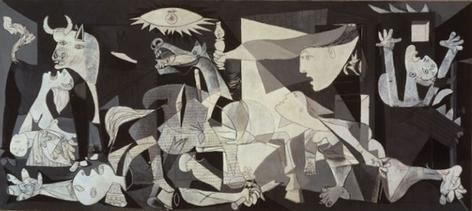 Guernica by Pablo Picasso. 1937. Oil on canvas. 349 cm × 776 cmWikipediaMy hero is Guernica, the mural size painting created by Pablo Picasso in response to the German bombing of the Basque town of Guernica, Spain in 1937. Picasso was born in Spain but he had actually moved to France. He read about the bombardment and the devastation that it had caused and he was deeply affected and saddened. He decided to paint a twenty-six foot long painting as his response.
Guernica by Pablo Picasso. 1937. Oil on canvas. 349 cm × 776 cmWikipediaMy hero is Guernica, the mural size painting created by Pablo Picasso in response to the German bombing of the Basque town of Guernica, Spain in 1937. Picasso was born in Spain but he had actually moved to France. He read about the bombardment and the devastation that it had caused and he was deeply affected and saddened. He decided to paint a twenty-six foot long painting as his response.
Since that time, the spring of 1937, Guernica has become a universal symbol for the human carnage that is the direct result of war and unchecked violence. Guernica illustrates the havoc that is wreaked upon humanity in times of war and in times of dictatorships. Picasso's style, Cubism, that he engages to represent this theme is exaggerated, dramatic, and highly emotional. Guernica conveys destruction, fragmentation, and helplessness, feelings that we associate with violence and cruelty. No matter what part of the globe you are from, Guernica registers the horrors of war.
Guernica was originally exhibited at the Spanish Pavilion of the Paris International Exposition in 1937. It aroused tremendous interest and sympathy for the victims of the German bombing. The painting then went to New York where it was housed in the Museum of Modern Art for many, many years. I grew up visiting this monumental, over life-size canvas and I became enlisted in the cause of peace and humanitarianism as a direct result of viewing and then understanding this powerful work of art. Guernica has since been returned to Spain as it is truly a masterwork of Spanish art and is part of that country's heritage of freedom from cruelty and dictatorships.
Today, reproductions of Guernica can be seen in textbooks, on CD covers, on backpacks, on t-shirts, on the walls of classrooms and on many, many websites. Guernica has become a painting for all people who celebrate peace and humanity. I nominate Guernica as my hero because it has inspired so many individuals and so many artists to express peace in their work and in their daily lives.
Page created on 8/12/2014 4:10:58 PM
Last edited 10/21/2019 5:00:59 PM
A very important source is the book/catalogue Pablo Picasso, A Retrospective, edited by William Rubin, New York, The Museum of Modern Art, and published in 1980.
In addition, there are many, many websites that feature Pablo Picasso, Guernica, the Prado Museum in Madrid, Spain and the Museum of Modern Art in New York City. Using the search engine "Google," you can locate many, many websites for each of these entries.
